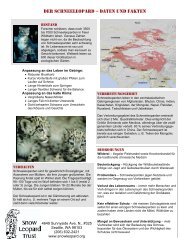Download the 7 Mb PDF file - Snow Leopard Trust
Download the 7 Mb PDF file - Snow Leopard Trust
Download the 7 Mb PDF file - Snow Leopard Trust
You also want an ePaper? Increase the reach of your titles
YUMPU automatically turns print PDFs into web optimized ePapers that Google loves.
Engaging Students in Conservation<br />
10<br />
Core Activity: Cat Characteristics<br />
(30-40 minutes)<br />
1. Tell <strong>the</strong> class that <strong>the</strong>y are about to<br />
investigate <strong>the</strong> physical characteristics<br />
of different cat species that help <strong>the</strong> cats<br />
survive in <strong>the</strong>ir habitats.<br />
2. Divide <strong>the</strong> class into groups of four.<br />
Distribute a bag of prepared Cat<br />
Characteristic Cards to each group.<br />
3. Provide each group with one copy of <strong>the</strong><br />
handout Four Ecosystems. You may want<br />
to review <strong>the</strong> definition of ecosystem<br />
with students.<br />
4. Give students a couple of minutes to<br />
construct four distinct cats using <strong>the</strong><br />
cards in <strong>the</strong>ir bag.<br />
5. Once cats are constructed, ask student<br />
groups to make educated guesses about<br />
which cat lives in each of <strong>the</strong> four<br />
ecosystems. Encourage <strong>the</strong>m to think<br />
about which characteristics make a cat<br />
more likely to live in one ecosystem<br />
versus ano<strong>the</strong>r.<br />
6. Pass out one Big Cat Facts sheet and one<br />
graphic organizer to each group. The<br />
fact sheet will allow <strong>the</strong>m to determine<br />
whe<strong>the</strong>r <strong>the</strong>y have correctly constructed<br />
and guessed <strong>the</strong> identity of <strong>the</strong> cats. Ask<br />
students within each group to take turns<br />
reading aloud about each of <strong>the</strong> four cat<br />
species.<br />
TERI AKIN<br />
The Cat’s out of <strong>the</strong> Bag!<br />
• (Optional) You may want to have<br />
students do <strong>the</strong>ir own research, ra<strong>the</strong>r<br />
than using <strong>the</strong> handout. The Big Cat<br />
Facts references may be used as starting<br />
points for research.<br />
7. Allow student groups 15-20 minutes<br />
to read <strong>the</strong> Big Cat Facts and complete<br />
<strong>the</strong> graphic organizer. You may want<br />
students to read <strong>the</strong> facts and highlight<br />
information or take notes prior to writing<br />
on <strong>the</strong> graphic organizer.<br />
8. Tell <strong>the</strong>m that this exercise is not just about<br />
wild cats in general but is an introduction<br />
to a study of snow leopards in particular.<br />
<strong>Snow</strong> leopards only live in <strong>the</strong> mountains<br />
of Central Asia and in zoos.<br />
9. Ask student groups to share <strong>the</strong> features<br />
of snow leopards, from <strong>the</strong> Facts sheet or<br />
from prior knowledge, that <strong>the</strong>y consider<br />
unique. What is most unusual about<br />
snow leopards?<br />
10. Explain that <strong>the</strong> snow leopard is one<br />
of <strong>the</strong> least known cat species in <strong>the</strong><br />
world. This is due to a small estimated<br />
population, its remote environment, its<br />
secretive behaviors, and a huge range<br />
(across twelve countries in Asia).<br />
11. Show one or more of <strong>the</strong> following<br />
short videos (each is 2-3 minutes) of<br />
snow leopards and <strong>the</strong>ir habitat from<br />
Discovery Channel’s Planet Earth:<br />
• http://dsc.discovery.com/videos/planetearth<br />
mountains-snow-leopard-hunt.html<br />
© FACING THE FUTURE www.facing<strong>the</strong>future.org & SNOW LEOPARD TRUST www.snowleopard.org<br />
1




